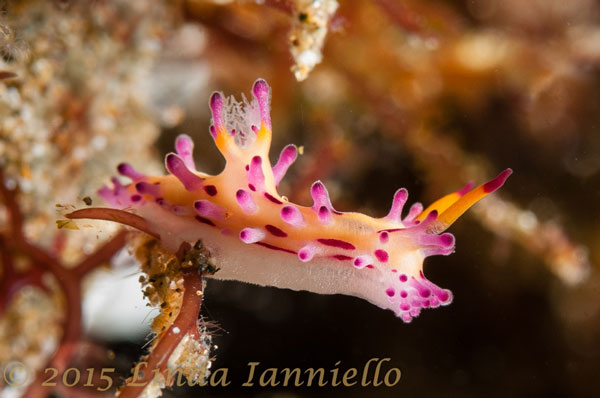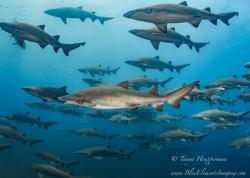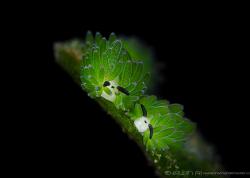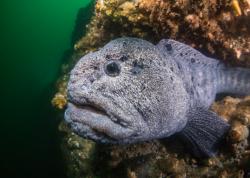How to Find Nudibranchs

Since nudibranchs come in such a huge variety of colors and shapes, they are a favorite subject of underwater macro photographers. It also helps that they are often sitting still, or at least moving slowly, so they can be relatively easy to photograph. But despite their bright colors they can be hard to find if you don’t know what to look for. This is where local knowledge is a huge help.
1. Local Knowledge
At home in southeast Florida, I have this local knowledge. I know what species are likely to be found, and that certain species can be found on hydroids, others in rubble, and still others on sponges. Some are out during the day, and others only come out at night. I have done hundreds of dives in the same area and know what to look for and where, which really helps my success rate at finding them.

Above is a Plocamopherus lucayensis from southeast Florida. It only comes out at night, and is generally found on this purplish bryozoan which is its food source.
Nikon D300s, Nikkor 60mm lens. ISO 200, f/29, 1/250

This is a Lomanotus vermiformis which is seasonal, generally found in the daytime during the summer. It is found on its food source, the feathery hydroid Lytocarpus philippinus.
Nikon D300s, Nikkor 60mm lens. ISO 100, f/16, 1/250
2. A Good Guide
When I am traveling to a new location I find that the best way to find nudibranchs is to use a local guide. They know what species are in the area, how big they are, and where they can be found. If you tell your guide that you are interested in seeing and photographing all the nudibranchs he or she can find, you will soon learn the underwater sign for nudibranchs and should have productive dives.

This Miamira alleni is quite rare. It had been seen in the same area for a couple of weeks, but I never would have seen it if the guide hadn’t found it on prior dives and knew roughly where it was located.
Nikon D300s, Nikkor 60mm lens. ISO 100, f/32, 1/250

I probably wouldn’t have seen this well-camouflaged Melibe engeli if the eagle-eyed guide hadn’t pointed it out.
Nikon D300s, Nikkor 60mm lens. ISO 200, f/32, 1/250
3. Research
If you are going to be on your own in a new location, first do some research on the Internet to see what nudibranchs have been seen in that area. This will give you an “imprint” image of what to look for and it will make spotting them easier. Check out the liveaboard/resort’s web site or Facebook page to determine what they have been finding recently. Then study the substrate the nudibranch is on (assuming it hasn’t been moved for the image). Or send them an email and ask! Two other good sources are the Facebook groups Nudibranch Central and Nudibase – Sharing Nudibranch Knowledge. Currently the two best reference books are Indo-Pacific Nudibranchs and Sea Slugs, which is out of print but an updated version is due out this fall, and Caribbean Sea Slugs. This research is a good idea even if you have a local guide; when he shows you a nudibranch, you will recognize what it is and have a better idea how to approach and photograph it. You will even know where the head is, which can be a challenge with some of them! (When photographing nudibranchs, you generally want the rhinophores in focus – those things that look like horns on the top of their head. The “feathery” things are the gills and focusing on them usually results in a butt shot!)

The rhinophores of this Phyllodesmium briareum are very similar in color and shape to its cerata so it is important to look closely and find the rhinophores before taking a shot. (The head is in the lower right corner of the image.)
Nikon D300s, Nikkor 60mm lens. ISO 200, f/32, 1/250
4. Food
Then do some additional research to try and find out what the local ones eat – nudibranchs are usually on or near their food source. This will give you an idea of where to look for specific ones. Once you find a species and want to learn more about it, a good resource is the Sea Slug Forum. It is no longer being maintained, but Dr. Bill Rudman spent a lot of time documenting a huge number of species, where they can be found, what they eat, and in many cases, what their eggs look like. The General topics section also contains a lot of interesting information about sea slugs.

Arminas feed on sea pens. Since the sea pens come out of the sand at night, whenever I do a night dive and see sea pens I start looking for Arminas. This one has its mantle folded back and you can see the gills between the mantle and the foot.
Nikon D300s, Nikkor 60mm lens. ISO 200, f/32, 1/250

Favorinus feed on the eggs of other opisthobranchs, notably the eggs of the Spanish dancer, Hexabranchus sanguineus. This image shows two species of Favorinus feeding on the eggs of an unknown sea slug. Whenever I see a string of eggs, I stop and check for the presence of Favorinus.
Nikon D300s, Nikkor 60mm lens. ISO 200, f/32, 1/250
You will note that I have used the term “nudibranch” throughout this article. Technically I should use the term “Sea Slugs” which covers numerous orders within the taxonomic group Opisthobranchia, one of which is nudibranchs, but also includes sap-sucking and solar-powered slugs, headshield slug, sidegill slugs, etc. But it has become common practice to use the term nudibranch to cover all of these.
My final message is “please do not move them or collect them for an aquarium”. They are usually on or near their food source, and if you move them they have to find it again. You may move them onto something that will make a pretty negative space, but it may attack the nudibranch. For example, some hard corals will attack a nudibranch placed on it. Or you may put them on something that the nudibranch would normally not crawl onto and therefore it is pretty obvious to those in the know that the subject has been moved. No photo is worth stressing or injuring the subject! And if you collect them for an aquarium, the chances are you won’t have their food; they are all very specialized feeders and they will likely die a slow death from starvation. I have even heard that “the nudibranch must be doing fine because it is laying eggs.” That is often a final effort by the nudibranch to propagate before dying.
Enjoy your slug-hunting and photography…… Hopefully these tips will help with the hunting!
Further Reading
RECOMMENDED ARTICLES
SUPPORT THE UNDERWATER PHOTOGRAPHY GUIDE:
The Best Service & Prices on u/w Photo Gear
 Visit Bluewater Photo & Video for all your underwater photography and video gear. Click, or call the team at (310) 633-5052 for expert advice!
Visit Bluewater Photo & Video for all your underwater photography and video gear. Click, or call the team at (310) 633-5052 for expert advice!
The Best Pricing, Service & Expert Advice to Book your Dive Trips
 Bluewater Travel is your full-service scuba travel agency. Let our expert advisers plan and book your next dive vacation. Run by divers, for divers.
Bluewater Travel is your full-service scuba travel agency. Let our expert advisers plan and book your next dive vacation. Run by divers, for divers.































